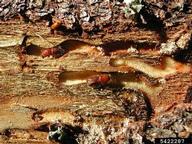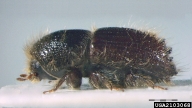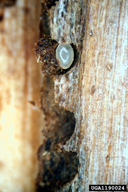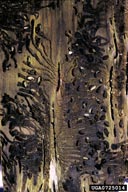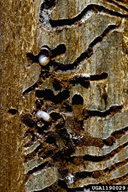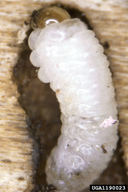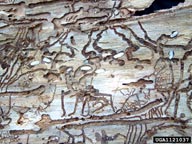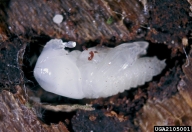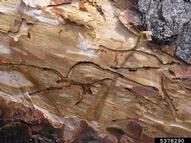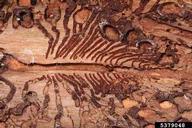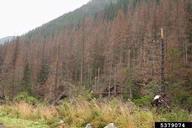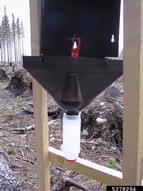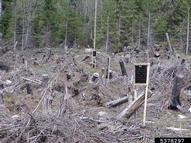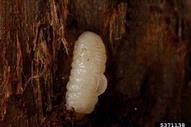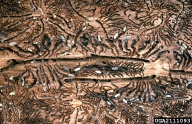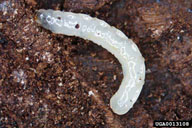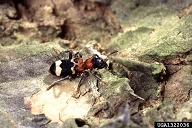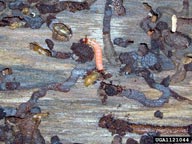Engraver beetle
Ips typographus (L.) (Coleoptera: Curculionidae, Scolytinae)
Orientation to pest
The engraver beetle, Ips typographus (L.), is native to Europe and has not yet invaded North America, but is a species of concern as a potentially serious pest of spruce (Picea). It is also referred to as the European spruce bark beetle. This species is the most damaging bark beetle in Europe, and historically many widespread infestations of long duration have occurred. As with many bark beetles, attack on living trees is facilitated by chemically coordinated mass attack and the vectoring of a tree-killing fungus, in this case Ceratocystis polonica Siem. The biology and life cycle of the insect is typical of bark beetles. Females dig oviposition galleries and deposit eggs along their length. Larvae then dig feeding galleries at right angles to the oviposition gallery, creating a fan-like appearance. Larvae pupate in chambers at the ends of larval galleries. Outbreaks are apparently initiated by events or conditions that increase quickly the number of stressed or dead trees available as breeding sites. Storms, drought, and logging (which increases the number of wind-thrown trees subseqeuently) have all been suggested as factors able to stimulate outbreaks. It has been suggested that natural enemies do not control low density populations, and that the regulatory factor is mortality from competition among larvae when breeding trees are scarce. However, other authors find that natural enemies cause up to 82% mortality to brood, suggesting they may indeed be important. Damage may be reduced by prompt removal of recently attacked trees because as many as 80% of parent beetles start a 'sister brood' within weeks. Mass trapping with a synthetic pheromone blend is also employed.
Hosts commonly attacked
This beetle attacks spruces (Picea), such as Norway spruce (Picea abies [L.] H.Karst)
Distribution
Engraver beetles are found throughout much of central Europe, Scandinavia, and east into Russia, northeastern China, Korea and Japan.
Images of engraver beetle
| Figure 1. Adults of the engraver beetle, Ips typographus (left: light brown, young adults, right: fully darkened, mature specimen) | Figure 2. Close up of one egg of the engraver beetle | |
| Figure 3. Larvae of engraver beetle (in a medium density infestation) | ||
| Figure 4. Pupae (left) of the engraver beetle in chambers at tips of larval galleries (in a low density infestation); right, close up of one pupa | ||
| Figure 5. Galleries of engraver beetles: left, adults cutting oviposition galleries; right, finished larval galleries branching off oviposition gallery with pupation chambers at tips | ||
| Figure 6. Spruce trees in Slovakia killed by the engraver beetle | Figure 7. Traps used to detect engraver beetles or for mass trapping (right, in logged area) | |
| Figure 8. Left, larva of external parasitoid on larva of engraver beetle; right, multiple cocoons of ichneumonid parasitoid formed in larval galleries of engraver beetle. (Also visible in photo in upper and lower areas are the galleries of the smaller, very common European species, Pityogenes chalcographus [L.]). | ||
| Figure 9. Larva of the long-legged fly Medetera signaticornis Loew, a specialized predator of bark beetle larvae, known only from Ips typographus, usually in high abundance in Western Europe. | Figure 10. The red-bellied clerid beetle, Thanasimus formicarius (L.) is an important predator of the engraver beetle in Europe (left, adult; right, larva) | |
Important biological control agents related to this pest species
The natural enemies of the engraver beetle have been reported from many locations and a large number of species of parasitoids and predators have been observed. Among the commonly reported species are the red-bellied clerid beetle (Thanasimus formicarius [L.]), the long-legged fly Medetera signaticornis Loew, and various braconid and ichneumonid parasitoids. See the review by Mills and Schlup (1989).
Web links for information on engraver beetle
- Screening Aid on BarkBeetles.org | Bugwood Network
Includes description of characters for species recognition - Invasive Risk Map | USDA Forest Service, FHTET
Forests in USA at potential risk from this bark beetle - Fact Sheet from Global Invasive Species Database | Invasive Species Specialist Group
Articles
- Mills, N. J. and M. Schlup. 1989. The natural enemies of Ips typographus in central Europe: Impact and potential use in biological control, pp. 131-146. In: Kulhavy, D. L. and M. C. Miller (eds.). Potential for Biological Control of Dendroctonus and Ips Bark Beetles. Published by the Center for Applied Studies, School of Forestry, Stephen F. Austin State University, Nacogdoches, Texas, USA
- Wermelinger, B. 2004. Ecology and management of the spruce bark beetle Ips typographus - a review of recent research. Forest Ecology and Management 202(1/3): 67-82.
- Grégoire, J.-C. and H. F. Evans. 2004. Damage and control of Bawbilt organisms - an overview, pp. 19 - 37. In:Lieutier, F., K. R. Day, A. Battisti, J.-C. Grégoire, and H. F. Evans (eds). Bark and Wood Boring Insects in Living Trees in Europe, a Synthesis. Springer, Netherlands.
